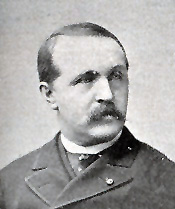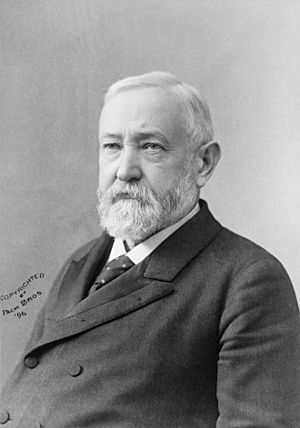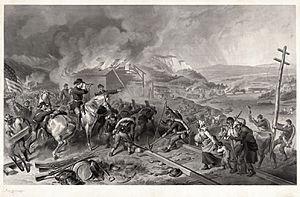George Washington Steele facts for kids
Quick facts for kids
George Washington Steele
|
|
|---|---|
 |
|
| Member of the U.S. House of Representatives from Indiana's 11th district |
|
| In office March 4, 1881 – March 3, 1889 |
|
| Preceded by | Calvin Cowgill |
| Succeeded by | Augustus N. Martin |
| In office March 4, 1895 – March 3, 1903 |
|
| Preceded by | Augustus N. Martin |
| Succeeded by | Frederick Landis |
| 1st Governor of Oklahoma Territory | |
| In office May 22, 1890 – October 18, 1891 |
|
| Appointed by | Benjamin Harrison |
| Preceded by | none |
| Succeeded by | Robert Martin as Acting Territorial Governor |
| Personal details | |
| Born | December 13, 1839 Fayette County, Indiana |
| Died | July 12, 1922 (aged 82) Marion, Indiana |
| Political party | Republican |
| Spouse | Marietta E. Swayzee |
| Profession | Lawyer, Soldier, Statesman |
George Washington Steele (born December 13, 1839 – died July 12, 1922) was an important American figure. He was a lawyer, a soldier, and a politician. Steele served as a Congressman for Indiana twice. He was also the first Governor of Oklahoma Territory. Steele played a big part in creating Oklahoma's public school system and its two largest universities.
Contents
Early Life and Military Service
George Washington Steele was born in Fayette County, Indiana, on December 13, 1839. His parents were Asbury and Marie Louise Steele. He went to public schools in Indiana. Later, he earned a law degree from Ohio Wesleyan University. After finishing his studies, Steele passed the bar exam. He then started his own law practice in Hartford City, Indiana.
Steele worked as a lawyer until 1861. This was when the American Civil War began. Indiana stayed loyal to the Union. Steele joined the Union Army as a volunteer on May 2, 1861. He was part of the 12th Indiana Regiment. Later, he moved to the 101st Indiana Regiment. He served in this regiment until the war ended.
Steele fought under Maj. Gen. William Tecumseh Sherman. He was part of Sherman's famous March to the Sea. After the Carolinas Campaign and the end of the war, Steele was promoted. In July 1865, he became a lieutenant colonel.
After the Civil War, Steele joined the Regular Army. He was promoted to major. He served in the 14th U.S. Infantry. His service in the Regular Army lasted for ten years. This was from February 23, 1866, to February 1876.
Political Career in Indiana

After leaving the army, Steele went back to Indiana. He settled in Marion. There, he started a business that worked with farming and packing pork. Steele joined the Republican Party because he was loyal to the Union. He became active in local politics.
In 1880, he won the election to become a Congressman for Indiana's 11th District. He started his job on March 4, 1881. He served for eight years, winning re-election in 1882, 1884, and 1886. He officially left office on March 3, 1889.
Governor of Oklahoma Territory
Less than a year after leaving Congress, a new area was formed. On May 2, 1890, the western part of what is now Oklahoma became the Oklahoma Territory. President Benjamin Harrison heard about problems and disorder in this new territory. He wanted a former military officer to be its first governor.
President Harrison chose Steele for the job. On May 22, 1890, Steele became governor in Guthrie, Oklahoma Territory.
Challenges and Achievements as Governor
As soon as he became governor, Steele declared a state of emergency. This allowed him to use his military experience to bring order. He worked to set up a proper government for the territory. However, he spent a lot of time dealing with arguments with the Oklahoma Territorial Legislature.
The Legislature wanted to move the capital from Guthrie. They first wanted to move it to Oklahoma City, then to Kingfisher. Governor Steele stopped all these attempts by using his veto power.
Steele also strongly pushed for public schools and universities in the Territory. Because of his efforts, the Legislature approved and created two universities. One was in Norman and the other in Stillwater. The Norman Territorial University later became the University of Oklahoma. The Stillwater A&M College became Oklahoma State University.
After only seventeen months, Governor Steele resigned on October 18, 1891. President Harrison then appointed Abraham Jefferson Seay as the next governor. Robert Martin, who was the Secretary of Oklahoma Territory, served as Acting Governor until February 1892.
Later Political Service and Retirement
After leaving the governorship, Steele returned to Marion, Indiana. He was a private citizen for a while. In 1894, he was elected to represent Indiana's 11th District in the United States House of Representatives again. His new term began on March 4, 1895.
While in the House, Steele helped establish a branch of the National Home for Disabled Volunteer Soldiers in Grant County, Indiana. This home provided care for soldiers who had been injured in the war. He introduced a bill for this in Congress, and it was approved in 1888. This was a very important project for the community.
Steele continued to serve as a Congressman until 1903, completing another eight years. He also served on the Board of Managers for the National Military Home at Marion. From 1904 until his retirement in 1915, he was the director of the Marion Branch of the home.
Death and Legacy
Steele retired and lived as a private citizen in Marion. He passed away on July 12, 1922, in Marion, at the age of 83. He is buried in Odd Fellows Cemetery there.
George Washington Steele's most lasting impact was in Oklahoma. He helped create Oklahoma Territory's first public school system. He also played a key role in starting Oklahoma's main universities: the University of Oklahoma and Oklahoma State University. Many people remember his time as Governor as very effective and brave.


